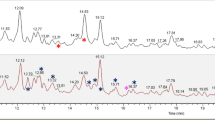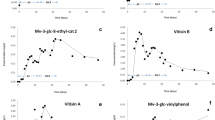Abstract
The reactivity of malvidin-3-O-glucoside with acetaldehyde, pyruvic and p-coumaric acids, was separately studied in wine model solution in the presence and absence of catechin, by UV–Visible spectrophotometry, NMR and Mass spectrometry. These naturally occurring metabolites were selected on account of their role in determining the red wine color. The scientific bases underlying the wine color are far from being fully clarified. Nonetheless, understanding the factors that govern the wine color is a crucial prerequisite for winemakers to implement appropriate technological practices to produce naturally stable high-quality wines. Among the investigated wine metabolites, acetaldehyde turned out to be the most reactive towards malvidin-3-O-glucoside by forming, as major products, ethylene-linked polymeric pigments that affected chromatic properties of the wine-like model solutions. Pyruvic acid and p-coumaric acid did not react with malvidin-3-O-glucoside, but in combination with catechin, they both determined a significant hypsochromic effect. Unexpectedly, in our model solutions, the formation of pyranoanthocyanins was not observed.




Similar content being viewed by others
References
Brouillard R, Dangle O (1994) Anthocyanins molecular interaction: the first step in the formation of new pigments during wine aging? Food Chem 51:365–371
Mateus N, Silva AMS, Santos-Buelga C, Rivas-Gonzalo JC, De Freitas V (2002) Identification of anthocyanin-flavanol pigments in red wines by NMR and mass spectrometry. J Agric Food Chem 2110–2116
Boulton R (2001) The copigmentation of anthocyanins and its role in the color of red wine: a critical review. Am J Enol Vitic 52:67–87
Brouillard R, Dubois JE (1977) Mechanism of the structural transformations of anthocyanins in acidic media. J Am Chem Soc 99:1359–1364
Mateus N, De Freitas V (2001) Evolution and stability of anthocyanin-derived pigments during Port wine aging. J Agric Food Chem 49:5217–5222
Fulcrand H, Benabdeljalil C, Rigaud J, Cheynier V, Moutounet M (1998) A new class of wine pigments generated by reaction between pyruvic acid and grape anthocyanins. Phytochemistry 47:1401–1407
Oliveira J, De Freitas V, Mateus N (2009) A novel synthetic pathway to vitisin B compounds. Tetrahedron Lett 50:3933–3935
Fulcrand H, Cameira dos Santos PJ, Sarni-Manchado P, Cheynier V, Bonvin JF (1996) Structure of new anthocyanin-derived wine pigments. J Chem Soc Perkin Trans 1:735–739
Bakker J, Timberlake CF (1997) Isolation, identification, and characterization of new color-stable anthocyanins occurring in some red wines. J Agric Food Chem 45:35–43
Lee DF, Swinny EE, Jones GP (2004) NMR identification of ethyl-linked anthocyanin–flavanol pigments formed in model wine ferments. Tetrahedron Lett 45:1671–1674
Gonzalez-Manzano S, Santos-Buelga C, Dueñas M, Rivas-Gonzalo JC, Escribano-Bailón T (2008) Colour implications of self-association processes of wine anthocyanins. Eur Food Res Technol 226:483–490
Dangles O, Fenger JA (2018) The chemical reactivity of anthocyanins and its consequences in food science and nutrition. Molecules 23:1970
Forino M, Gambuti A, Luciano P, Moio L (2019) Malvidin-3-O-glucoside chemical behavior in the wine pH range. J Agric Food Chem 67:1222–1229
Oliveira CM, Ferreira ACS, De Freitas V, Silva AMS (2011) Oxidation mechanisms occurring in wines. Food Res Int 44(5):1115–1126
Atanasova V, Fulcrand H, Le Guernevé C, Cheynier V, Moutounet M (2002) Structure of a new dimeric acetaldehyde malvidin-3-glucoside condensation product. Tetrahedron Lett 43:6151–6153
Fulcrand H, Duenas M, Salas E, Cheynier V (2006) Phenolic reactions during winemaking and aging. Am J Enol Vitic 57:289–297
Mirabel M, Saucier C, Guerra C, Glories Y (1999) Copigmentation in model wine solutions: occurrence and relation to wine aging. Am J Enol Vitic 50(2):211–218
Berké B, De Freitas V (2007) A colorimetric study of oenin copigmented by procyanidins. J Sci Food Agric 87(2):260–265
Lambert SG, Asenstorfer RE, Williamson NM, Iland PG, Jones GP (2011) Copigmentation between malvidin-3-glucoside and some wine constituents and its importance to colour expression in red wine. Food Chem 125:106–115
Martinez JA, Melgosa M, Pérez MM, Hita E, Negueruela AI (2001) Visual and instrumental color evaluation in red wines. Food Sci Technol Int 7(5): 439–444
Author information
Authors and Affiliations
Corresponding author
Ethics declarations
Conflict of interest
The authors declare that they have no conflict of interest.
Ethical approval
This article does not contain any studies with human or animal subjects.
Additional information
Publisher's Note
Springer Nature remains neutral with regard to jurisdictional claims in published maps and institutional affiliations.
Electronic supplementary material
Below is the link to the electronic supplementary material.
Rights and permissions
About this article
Cite this article
Forino, M., Picariello, L., Lopatriello, A. et al. New insights into the chemical bases of wine color evolution and stability: the key role of acetaldehyde. Eur Food Res Technol 246, 733–743 (2020). https://doi.org/10.1007/s00217-020-03442-x
Received:
Accepted:
Published:
Issue Date:
DOI: https://doi.org/10.1007/s00217-020-03442-x




